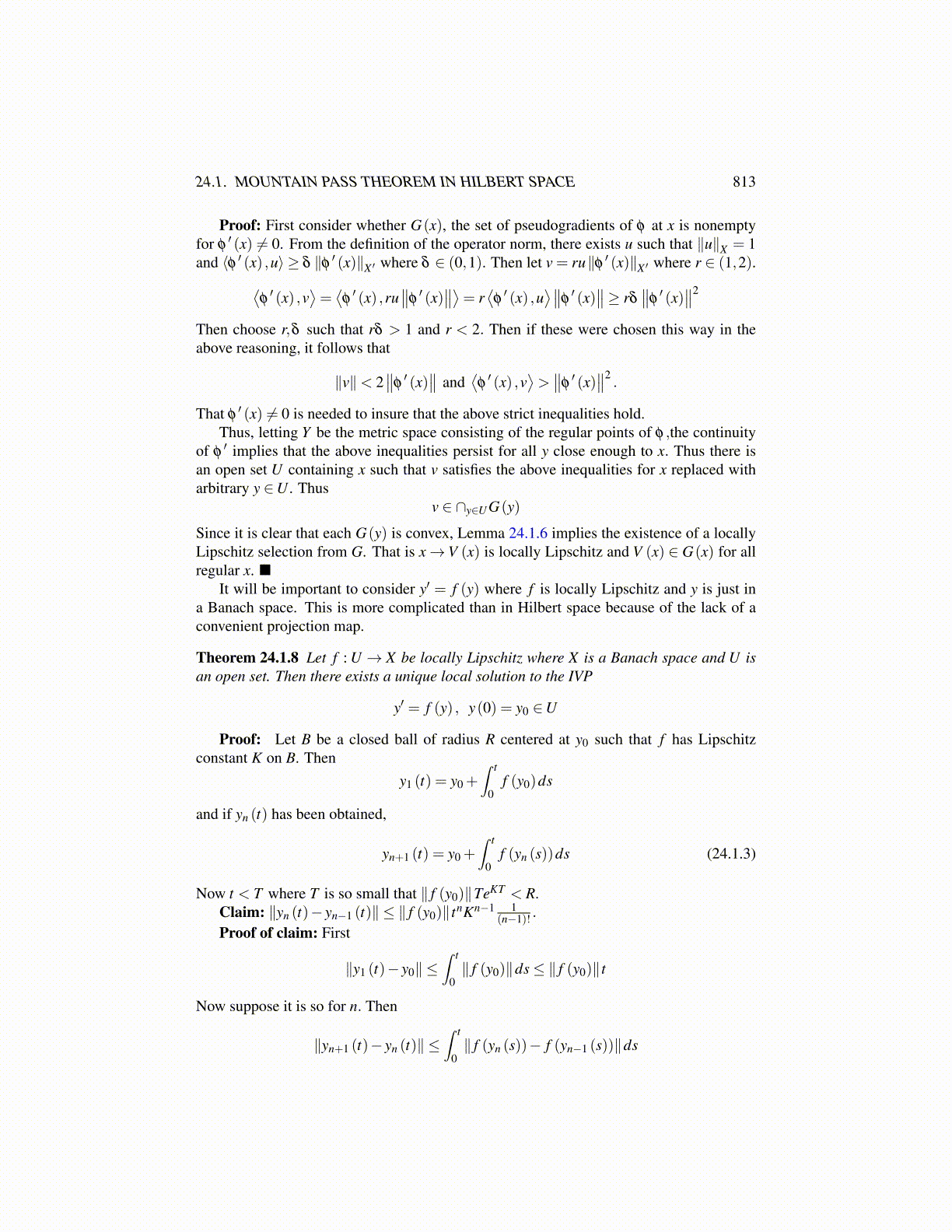
24.1. MOUNTAIN PASS THEOREM IN HILBERT SPACE 813
Proof: First consider whether G(x), the set of pseudogradients of φ at x is nonemptyfor φ
′ (x) ̸= 0. From the definition of the operator norm, there exists u such that ∥u∥X = 1and ⟨φ ′ (x) ,u⟩ ≥ δ ∥φ ′ (x)∥X ′ where δ ∈ (0,1). Then let v = ru∥φ ′ (x)∥X ′ where r ∈ (1,2).⟨
φ′ (x) ,v
⟩=⟨φ′ (x) ,ru
∥∥φ′ (x)
∥∥⟩= r⟨φ′ (x) ,u
⟩∥∥φ′ (x)
∥∥≥ rδ∥∥φ′ (x)
∥∥2
Then choose r,δ such that rδ > 1 and r < 2. Then if these were chosen this way in theabove reasoning, it follows that
∥v∥< 2∥∥φ′ (x)
∥∥ and⟨φ′ (x) ,v
⟩>∥∥φ′ (x)
∥∥2.
That φ′ (x) ̸= 0 is needed to insure that the above strict inequalities hold.
Thus, letting Y be the metric space consisting of the regular points of φ ,the continuityof φ
′ implies that the above inequalities persist for all y close enough to x. Thus there isan open set U containing x such that v satisfies the above inequalities for x replaced witharbitrary y ∈U . Thus
v ∈ ∩y∈U G(y)
Since it is clear that each G(y) is convex, Lemma 24.1.6 implies the existence of a locallyLipschitz selection from G. That is x→V (x) is locally Lipschitz and V (x) ∈ G(x) for allregular x.
It will be important to consider y′ = f (y) where f is locally Lipschitz and y is just ina Banach space. This is more complicated than in Hilbert space because of the lack of aconvenient projection map.
Theorem 24.1.8 Let f : U → X be locally Lipschitz where X is a Banach space and U isan open set. Then there exists a unique local solution to the IVP
y′ = f (y) , y(0) = y0 ∈U
Proof: Let B be a closed ball of radius R centered at y0 such that f has Lipschitzconstant K on B. Then
y1 (t) = y0 +∫ t
0f (y0)ds
and if yn (t) has been obtained,
yn+1 (t) = y0 +∫ t
0f (yn (s))ds (24.1.3)
Now t < T where T is so small that ∥ f (y0)∥TeKT < R.Claim: ∥yn (t)− yn−1 (t)∥ ≤ ∥ f (y0)∥ tnKn−1 1
(n−1)! .
Proof of claim: First
∥y1 (t)− y0∥ ≤∫ t
0∥ f (y0)∥ds≤ ∥ f (y0)∥ t
Now suppose it is so for n. Then
∥yn+1 (t)− yn (t)∥ ≤∫ t
0∥ f (yn (s))− f (yn−1 (s))∥ds